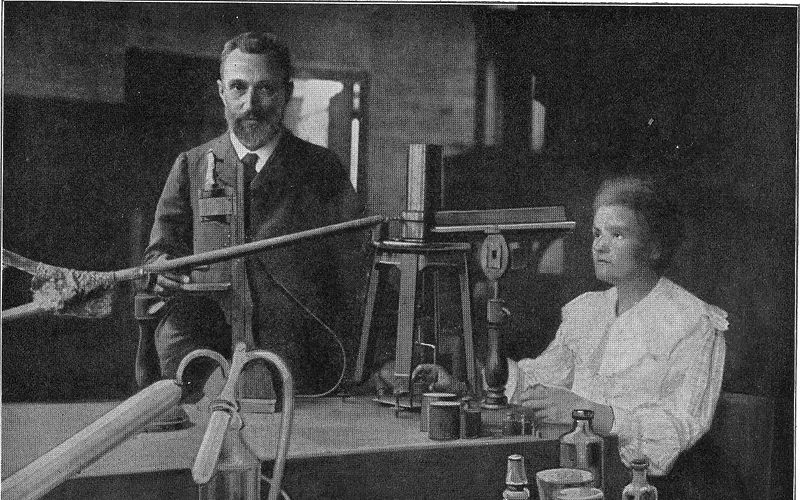| << Chapter < Page | Chapter >> Page > |
Temporarily called radium F , polonium was discovered by Marie Curie and her husband Pierre Curie ( [link] ) in 1898, but it was later named after Marie Curie's native land of Poland. At the time Poland was not an independent country, but partitioned under Russian, Prussian, and Austrian. It was Curie's hope that naming the element after her native land would publicize its lack of independence. Polonium was the first chemical element named to highlight a political controversy.

The abundance of the chalcogenes is given in [link] .
| Element | Terrestrial abundance (ppm) |
| O | 47 x 10 4 (Earth’s crust), constituent of water, 21 x 10 4 (atmosphere) |
| S | 260 (Earth’s crust), 870 (sea water), 10 -3 (atmosphere) |
| Se | 0.05 (Earth’s crust), 5 (soil), 0.2 x 10 -3 (sea water) |
| Te | 5 x 10-3 (Earth’s crust), 0.03 (soil), 0.15 x 10 -6 (sea water) |
| Po | Trace (Earth’s crust) |
The naturally abundant isotopes of the Group 16 elements are listed in [link] . All of the isotopes of polonium are radioactive.
| Isotope | Natural abundance (%) |
| Oxygen-16 | 99.76 |
| Oxygen-17 | 0.039 |
| Oxygen-18 | 0.201 |
| Sulfur-32 | 95.02 |
| Sulfur-33 | 0.75 |
| Sulfur-34 | 4.21 |
| Sulfur-36 | 0.02 |
| Selenium-74 | 0.87 |
| Selenium-76 | 9.36 |
| Selenium-77 | 7.63 |
| Selenium-78 | 23.78 |
| Selenium-80 | 49.61 |
| Tellurium-120 | 0.09 |
| Tellurium-122 | 2.55 |
| Tellurium-123 | 0.89 |
| Tellurium-124 | 4.74 |
| Tellurium-125 | 7.07 |
| Tellurium-126 | 18.84 |
| Tellurium-128 | 31.74 |
| Tellurium-130 | 34.08 |
There are 38 known nuclear isomers of tellurium with atomic masses that range from 105 to 142. Tellurium is the lightest element known to undergo alpha decay, with isotopes 106 Te to 110 Te being able to undergo this mode of decay.
Ever since the early 1960s, the presence of polonium-210 in tobacco smoke has been known. The world's biggest tobacco firms spent over 40 years trying to find ways to remove the polonium-210 without success: even to this day. However, they also never published the results, keeping the facts of the radioactive hazards from the consumer.
Radioactive polonium-210 is contained in phosphate fertilizers and is absorbed by the roots of plants (such as tobacco) and stored in its tissues. Tobacco plants fertilized by rock phosphates contain polonium-210, which emits alpha radiation estimated to cause about 11,700 lung cancer deaths annually worldwide.
Elemental sulfur is found near hot springs and volcanic regions in many parts of the world. Volcanic deposits are mined in Indonesia, Chile, and Japan. Significant deposits of sulfur also exist in salt domes along the coast of the Gulf of Mexico, and in eastern Europe and western Asia. The sulfur in these deposits is believed to come from the action of anaerobic bacteria on sulfate minerals. However, fossil-based sulfur deposits from salt domes are the basis for commercial production in the United States, Poland, Russia, Turkmenistan, and Ukraine.Sulfur is mainly extracted from natural sources by two processes: the Sicilian process and the Frasch process.

Notification Switch
Would you like to follow the 'Chemistry of the main group elements' conversation and receive update notifications?